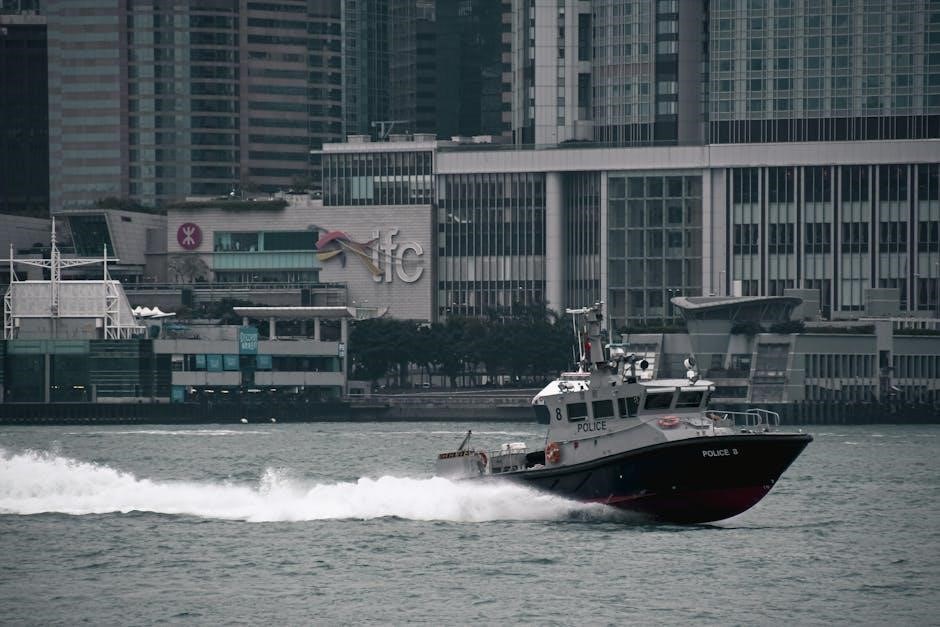Newton’s Laws of Motion are fundamental principles in physics describing how objects move and respond to forces. These laws form the foundation of classical mechanics.
The three laws explain inertia, force and acceleration, and action-reaction forces, providing a framework to understand motion and forces acting on objects.
These laws are essential for analyzing real-world phenomena, from rocket propulsion to everyday movements, helping predict and explain physical interactions.
This worksheet covers definitions, examples, and practice problems for each law, offering a comprehensive approach to mastering Newton’s principles of motion.
1.1 Overview of Newton’s Laws
Newton’s Laws of Motion are three fundamental principles that describe how objects move and respond to forces. The First Law, or the Law of Inertia, states that an object will remain at rest or in uniform motion unless acted upon by an external force. The Second Law relates force, mass, and acceleration, expressed by the equation ( F = ma ), showing that the acceleration of an object depends on the net force and its mass. The Third Law explains that every action force has an equal and opposite reaction force. Together, these laws provide a comprehensive framework for understanding and predicting the motion of objects under various forces.
1.2 Importance of Understanding Newton’s Laws
Understanding Newton’s Laws is crucial as they form the foundation of classical mechanics, enabling us to predict and explain how objects move under various forces. These laws are essential for solving problems in physics, engineering, and everyday scenarios, such as calculating acceleration or understanding rocket propulsion. They provide a framework for analyzing complex phenomena and are vital for advancements in technology and science. Grasping these principles enhances problem-solving skills and deepens the comprehension of natural interactions, making them indispensable in both academic and practical applications.
1.3 Structure of the Worksheet
This worksheet is organized to guide learners through Newton’s Laws of Motion systematically. It begins with an introduction, followed by detailed sections on each law, including definitions, real-life examples, and practice problems. The problems range from basic to advanced, allowing learners to apply their understanding of concepts like inertia, force, and action-reaction. Solutions are provided for each problem, enabling self-assessment and reinforcement of learning. The worksheet also includes sections on real-world applications, such as transportation and sports, to illustrate the practical relevance of Newton’s Laws. This structured approach ensures a comprehensive understanding and mastery of the topic through hands-on practice and analysis.

Newton’s First Law of Motion
Newton’s First Law, or the Law of Inertia, states that an object remains at rest or moves at constant velocity unless acted upon by an external force.
2.1 Definition of the Law of Inertia
Newton’s First Law of Motion, known as the Law of Inertia, states that an object will remain at rest or continue moving at a constant velocity unless acted upon by an external force. Inertia is the property of matter that describes an object’s resistance to changes in its motion. This law explains that objects maintain their state of motion unless a force disrupts it, emphasizing the role of external forces in altering motion. For example, a rolling ball will continue moving unless friction or another force stops it, while a stationary book remains still until a force compels it to move.
2.2 Examples of the First Law in Real Life
The Law of Inertia is evident in everyday situations. For instance, when a car suddenly stops, passengers continue moving forward until restrained by seatbelts, demonstrating inertia. Similarly, a ball rolling on a frictionless surface maintains its motion indefinitely. Another example is a coffee cup in a moving car; if the car brakes sharply, the cup continues moving forward unless acted upon by an external force, like a hand or the dashboard. These examples illustrate how objects resist changes in their motion, aligning with Newton’s First Law and its principle of inertia.
2.3 Practice Problems on the First Law
A 5 kg box is at rest on a frictionless table. If no external force is applied, what will be its state of motion?
A car is moving at a constant velocity of 30 m/s on a flat road. What net force acts on it?
A book is placed on a table. Why doesn’t it accelerate downward?
A hockey puck slides on ice with negligible friction. If no external force acts on it, how will its motion change over time?
Explain why seatbelts are essential in cars using Newton’s First Law.
2.4 Solutions to Practice Problems
The box remains at rest due to inertia, as no external force acts on it.
The net force on the car is zero, maintaining its constant velocity.
The table exerts an equal upward force balancing the book’s weight, preventing downward acceleration.
The puck continues moving at a constant speed in a straight line without external forces.
Seatbelts prevent injury by restraining passengers who, due to inertia, continue moving forward during sudden stops.

Newton’s Second Law of Motion
Newton’s Second Law relates force, mass, and acceleration through the formula ( F = ma ). It explains how force applied to an object affects its acceleration, based on its mass.
3.1 Force, Mass, and Acceleration Relationship
The relationship between force, mass, and acceleration is central to Newton’s Second Law, expressed as ( F = ma ). Here, force ((F)) is measured in Newtons (N), mass ((m)) in kilograms (kg), and acceleration ((a)) in meters per second squared (m/s²). This equation shows that force applied to an object is directly proportional to its acceleration and mass. For example, doubling the force on an object doubles its acceleration, while doubling the mass halves the acceleration for the same force. Understanding this relationship is key to predicting how objects respond to external forces in various scenarios, from everyday movements to complex engineering problems.
- Force ((F)) is the push or pull acting on an object.
- Mass ((m)) represents the amount of matter in an object.
- Acceleration ((a)) is the rate of change in velocity over time.
This relationship helps calculate unknown quantities when two are known, making it a foundational tool in physics and engineering. Graphical representations, such as force vs. acceleration graphs, can also illustrate this relationship effectively.
3.2 The Formula F = ma
The formula ( F = ma ) is the mathematical expression of Newton’s Second Law, where force (( F )) equals mass (( m )) multiplied by acceleration (( a )). This equation allows calculation of an unknown variable when the other two are known. For instance, if the force applied to an object is 20 N and its mass is 5 kg, the acceleration can be found by rearranging the formula to ( a = rac{F}{m} ), resulting in ( a = 4 , ext{m/s}^2 ). Units are crucial: force in Newtons (N), mass in kilograms (kg), and acceleration in meters per second squared (( ext{m/s}^2 )).

- ( F ): The net force applied to the object.
- ( m ): The mass of the object being accelerated.
- ( a ): The resulting acceleration of the object.
This formula is widely used in physics and engineering to solve problems involving force, mass, and motion, making it a cornerstone of dynamics.

3.3 Examples Illustrating the Second Law
Newton’s Second Law is demonstrated through practical examples. For instance, when a force of 40 N is applied to a system of two boxes (12 kg and 10 kg) connected by a cord, the acceleration is calculated as ( a = rac{F}{m} = rac{40}{22} = 1.6 , ext{m/s}^2 ). Similarly, applying 85 N to a 17 kg and 23 kg system results in ( a = rac{85}{40} = 2.1 , ext{m/s}^2 ). These examples show how force and mass determine acceleration, aligning with ( F = ma ). Such problems are common in physics, helping students grasp the law’s application in real-world scenarios.
- Force applied: 40 N → Acceleration: 1.6 m/s².
- Force applied: 85 N → Acceleration: 2.1 m/s².
3.4 Practice Problems on the Second Law
Practice solving problems using Newton’s Second Law with the following examples:
- A force of 30 N is applied to a 5 kg object. What is the acceleration?
Answer: a = F/m = 30/5 = 6.0 m/s².
- A 50 N force is applied to a 10 kg box. Calculate the acceleration.
Answer: a = 50/10 = 5.0 m/s².
- A 20 N force causes a 4 kg object to accelerate. Find the acceleration.
Answer: a = 20/4 = 5.0 m/s².
These problems reinforce understanding of the relationship between force, mass, and acceleration.
3.5 Solutions to Practice Problems
Here are the solutions to the practice problems based on Newton’s Second Law:
- Problem: A force of 30 N is applied to a 5 kg object. What is the acceleration?
Solution: Using F = ma → a = F/m = 30/5 = 6.0 m/s².
- Problem: A 50 N force is applied to a 10 kg box. Calculate the acceleration.
Solution: a = F/m = 50/10 = 5.0 m/s².
- Problem: A 20 N force causes a 4 kg object to accelerate. Find the acceleration.
Solution: a = F/m = 20/4 = 5.0 m/s².
These solutions demonstrate how to apply Newton’s Second Law to calculate acceleration when force and mass are known;

Newton’s Third Law of Motion
Newton’s Third Law states that every action force is accompanied by an equal and opposite reaction force, as seen in rocket propulsion and swimming motions.
4.1 Action and Reaction Forces
Action and reaction forces are equal and opposite forces that occur simultaneously between two interacting objects. According to Newton’s Third Law, every action force exerted by one object is met with an equal and opposite reaction force by the other. For example, when a rocket expels fuel backward, it moves forward due to the reaction force. Similarly, when you paddle a canoe, the water pushes backward, propelling the canoe forward. These forces do not cancel each other out because they act on different objects. Understanding this principle is crucial for analyzing interactions in systems like rockets, sports, and everyday motion.
4.2 Examples of the Third Law in Action
Newton’s Third Law is evident in various real-world scenarios. For instance, when a rocket ejects fuel backward, it moves forward due to the reaction force. Similarly, when you paddle a canoe, the water pushes backward, propelling the canoe forward. In a game of tug-of-war, the force exerted by one team is matched by the opposing team, creating tension. Even walking involves the Third Law, as the ground exerts an equal and opposite force to the pressure from your feet. These examples illustrate how action and reaction forces are always present and essential for motion and interaction in the physical world.
4.3 Practice Problems on the Third Law
A rocket expels gas backward with a force of 500 N. What is the forward thrust on the rocket?
During a spacewalk, an astronaut applies a force of 100 N on a spacecraft. What is the reaction force on the astronaut?
Two people push against each other with equal forces. If one exerts 200 N, what is the force on each?
Calculate the reaction force when a car accelerates forward with a force of 1500 N.
These problems help apply Newton’s Third Law to real-world action-reaction scenarios, enhancing understanding of force interactions.
4.4 Solutions to Practice Problems
The forward thrust on the rocket is 500 N, as the reaction force to the gas expelled backward.
The reaction force on the astronaut is 100 N, opposite to the force applied on the spacecraft.
Each person experiences a force of 200 N, equal and opposite to the force exerted by the other.
The reaction force on the car is 1500 N forward, equal to the force exerted backward on the ground.
These solutions demonstrate the principle of equal and opposite forces as per Newton’s Third Law.

Solving Problems Using Newton’s Laws
Mastering problem-solving with Newton’s Laws involves systematic approaches. Start by identifying forces, drawing free-body diagrams, and applying F = ma. Calculate net force, acceleration, and mass. Verify units and reasonableness of answers. Practice with real-world scenarios like inclined planes or connected masses. Break complex systems into simpler parts and iterate solutions. This method ensures clarity and accuracy in applying Newton’s principles to dynamic situations.
- Define the system and sketch interactions.
- Apply relevant laws step-by-step.
- Check for unit consistency.
- Validate results for physical plausibility.
5.1 Free-Body Diagrams and Net Force
A free-body diagram visually represents all forces acting on an object. It simplifies problem-solving by isolating the object and illustrating each force’s direction and magnitude. To draw one, identify the object, sketch it, and label all forces acting on it, such as friction, tension, or applied forces. The net force is the vector sum of all forces, crucial for applying Newton’s Second Law (F = ma). Accurate free-body diagrams help identify the net force, enabling precise calculations of acceleration or mass. They are essential for understanding complex force interactions in real-world problems, ensuring clarity and accuracy in solving physics challenges.
5.2 Calculating Acceleration
Acceleration is calculated using Newton’s Second Law, ( F = ma ), where ( a = rac{F}{m} ). The net force ( F ) is found by summing all forces acting on an object. Mass ( m ) is the object’s resistance to acceleration. Once ( F ) and ( m ) are known, divide ( F ) by ( m ) to find ( a ); Units are in meters per second squared (m/s²). For example, if a 10 N force acts on a 2 kg object, ( a = rac{10}{2} = 5 , ext{m/s²} ). This process is fundamental for predicting motion in various physics problems, ensuring accurate results in real-world applications.
5.3 Systems of Objects and Connected Masses
When dealing with systems of objects and connected masses, Newton’s laws apply to the entire system. For objects connected by cords or in contact, the net external force determines the system’s acceleration. To solve such problems:
- Identify all external forces acting on the system.
- Combine the masses to find the total mass (m_total = m1 + m2 + .;.).
- Use F_net = m_total * a to find the acceleration of the system.
- Assume a frictionless surface unless stated otherwise.
This approach simplifies complex systems by treating them as single entities, making it easier to apply Newton’s Second Law effectively in various scenarios.
5.4 Advanced Problem-Solving Techniques
Advanced problem-solving techniques involve applying Newton’s laws to complex scenarios, such as systems with multiple forces or objects in motion. Start by identifying all forces acting on the system and use free-body diagrams to visualize them. Break forces into components (horizontal and vertical) and apply Newton’s Second Law to each axis. For connected masses, treat the system as a whole and use the combined mass. When dealing with pulleys, consider the relationship between acceleration and tension. Verify assumptions and check units and dimensions to ensure consistency. Practice these methods to enhance problem-solving skills in dynamics and kinematics.

Real-World Applications of Newton’s Laws
Newton’s laws apply to everyday phenomena like vehicle braking, rocket propulsion, and athletic movements, demonstrating how fundamental physics principles govern real-world mechanics and engineering solutions.
6.1 Inertia in Transportation
Inertia, governed by Newton’s First Law, plays a crucial role in transportation. When a vehicle accelerates or brakes, passengers experience inertia, resisting changes in motion. For instance, when a car suddenly stops, passengers continue moving forward due to inertia, highlighting the importance of seatbelts to prevent injury. Similarly, airbags deploy to cushion the force of impact, demonstrating how understanding inertia aids in safety design. In vehicles, proper engineering accounts for inertial forces, ensuring stability and safety during acceleration, deceleration, and sharp turns. This principle is vital for developing safety features and improving transportation efficiency and safety standards.
6.2 Action-Reaction in Rocket Propulsion
Newton’s Third Law is fundamental to rocket propulsion. When a rocket expels fuel backward, it experiences an equal and opposite reaction force propelling it forward. This action-reaction principle ensures continuous motion in space, where external forces are absent. The rocket’s engines produce thrust by ejecting mass at high speed, creating a forward force. This demonstrates how Newton’s Third Law enables space exploration by providing the necessary propulsion for rockets to overcome gravity and travel vast distances. The efficiency of this principle relies on the mass and velocity of the expelled fuel, showcasing its practical application in advanced transportation technology.

6.3 Newton’s Laws in Sports
Newton’s Laws are integral to understanding athletic movements and equipment performance. In football, Newton’s First Law explains why a tackle stops a player’s motion. The Second Law relates to the force applied in activities like cycling, where pedaling harder increases acceleration. The Third Law is evident in running, as the ground’s reaction force propels the athlete forward. These principles also apply to sports equipment, such as how a baseball bat transfers force to the ball. By understanding these laws, athletes and coaches can optimize training and performance, highlighting the practical relevance of physics in sports.
6.4 Engineering Applications
Newton’s Laws are foundational in engineering, enabling the design of safe and efficient systems; In aerospace engineering, Newton’s Third Law explains rocket propulsion, where expelled fuel generates thrust. Civil engineers apply the First Law to ensure bridges and buildings withstand external forces without collapsing. The Second Law is crucial for calculating structural integrity and material stress. Robotics and automotive industries rely on these principles to optimize machine performance and safety. By applying Newton’s Laws, engineers can predict how forces affect designs, ensuring reliability and innovation in various technological advancements.

Practice Problems and Answers
This section provides a variety of practice problems across all three laws, with detailed solutions to help students master Newton’s principles through hands-on application.
7.1 Beginner-Level Problems
Beginner-level problems focus on basic applications of Newton’s Laws, such as calculating acceleration using F=ma, identifying forces acting on objects, and understanding inertia. For example, problems might ask to determine the force needed to accelerate an object or explain why a stationary object remains at rest. These questions are designed to build a foundational understanding of how forces and motion interact, using simple numerical scenarios and conceptual explanations. They also introduce free-body diagrams to visualize forces. Answers are provided to guide learning and reinforce key concepts of Newton’s Laws in everyday situations.
7.2 Intermediate-Level Problems
Intermediate-level problems involve more complex applications of Newton’s Laws, such as calculating acceleration in systems with multiple objects or analyzing forces in connected mass scenarios. These problems often require the use of free-body diagrams to visualize and sum forces acting on objects. Examples include determining the acceleration of two boxes connected by a cord or finding the tension in a rope when lifting an object. Students are also asked to apply Newton’s Third Law in real-world contexts, such as rocket propulsion or action-reaction pairs. These problems build on foundational knowledge, introducing variables like friction and inertia in dynamic systems. Answers are provided to verify solutions and deepen understanding.
7.3 Advanced-Level Problems
Advanced-level problems challenge students to apply Newton’s Laws in complex, real-world scenarios, often involving multiple forces, inclined planes, and systems of objects. These problems require the use of free-body diagrams to accurately visualize and calculate net forces. Examples include determining the acceleration of objects on inclines with friction, analyzing forces in pulley systems with varying masses, and solving for tension in ropes with multiple attachments. Students must also integrate Newton’s Laws with other physics concepts, such as torque and rotational motion. These problems enhance critical thinking and problem-solving skills, preparing students for practical engineering and physics applications. Detailed solutions are provided for comprehensive understanding.
7.4 Answers to Practice Problems
The answers section provides detailed solutions to all practice problems, ensuring clarity and understanding. Each solution is structured to show the application of Newton’s Laws, with step-by-step calculations. For example, problems involving forces and acceleration use the formula ( F = ma ) to determine unknowns like mass or acceleration. Solutions for systems of objects and connected masses include free-body diagrams to visualize forces. Answers are presented with proper units and precision, matching the accuracy of given measurements. This section serves as a valuable resource for students to verify their work and improve problem-solving skills in physics.




